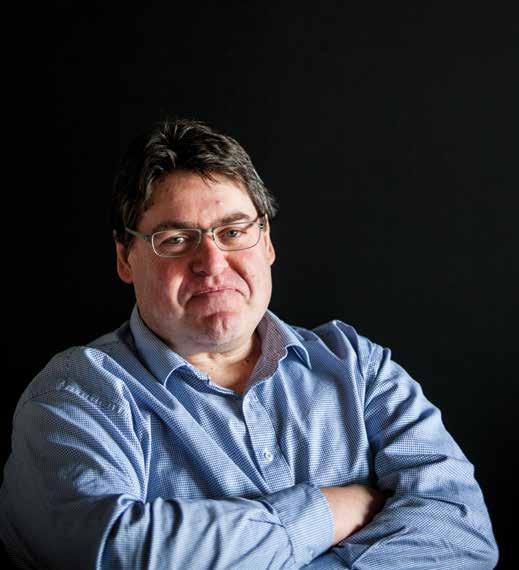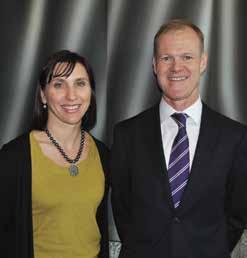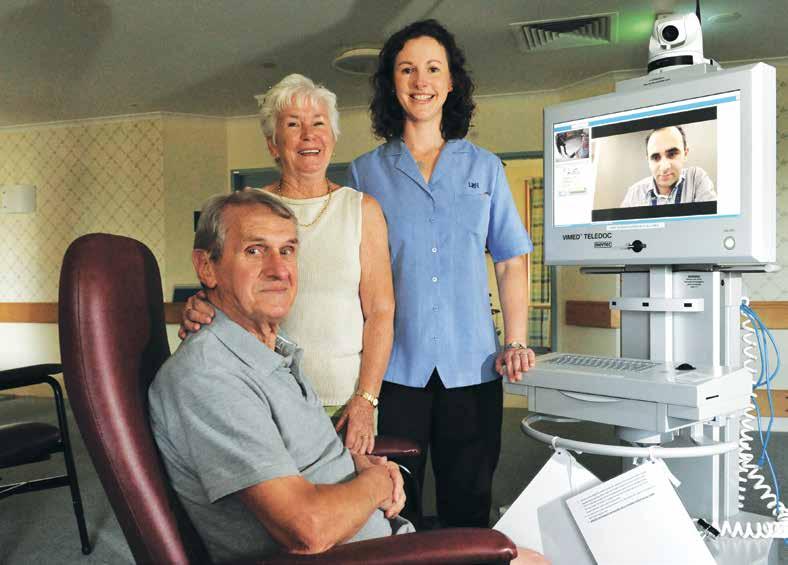
7 minute read
A creepy but brilliant solution
The University of Queensland's Professor Glenn King, whose specialty is venomics, was part of that discussion. “Ah,” he said. “We’ve got one.”
Steve recalls the moment as “just like a bang. It’s happenstance; it came together.”
The encounter, he says, was further evidence in support of a favoured saying by Florey director Professor Geoffrey Donnan that “science is a contact sport”.
Picking up another metaphor, the team compared the problem to two light switches being turned on and off quickly. The result would be a bright flash. But with the mutation causing just one light to work, Steve wondered whether it was possible to keep the light on longer.
“It’s not as bright, but there was as much light coming out over a slightly longer period. But was that the same as two going on? That was our concern.”
The result was a resounding yes.
“We gave this drug to one of these neurones and it looked exactly like a normal one,” Steve says.
“I looked at it and thought, ‘Oh my goodness, that’s amazing’.”
The potential treatment that could flow from the research fits into the category of targeted therapy. With epilepsy, there are drugs to deal with seizures – the final stage of the affliction.
Afew years ago, Professor Steven Petrou was on Queensland’s Stradbroke Island, at a retreat for a group of scientists investigating the use of spider and other venoms to relieve pain.
Steve was talking to colleagues about his work on Dravet Syndrome, a catastrophic form of epilepsy that begins in infancy. Then came the encounter that would change everything.
The Florey’s deputy director and head of our epilepsy division, was explaining how he and his team were investigating a mutation in a sodium channel, SCN1A. As Steve puts it, this channel is “the little switch that turns a neurone on.”
He uses a car metaphor to explain the concept. There are two types of neurones in the brain: those that act like the accelerator and excite the brain, and others that inhibit the brain, the brake. It is the balance between these two –the accelerator and the brake – that gives us healthy brain function.
Suddenly Steve had access to venomics research teams who were working with the chemistry of venoms from arthropod predators – think spiders, scorpions and centipedes – to develop novel pharmaceuticals to treat chronic pain, epilepsy and stroke.
Venoms are a great source of biologically active substances. A 100 million years or so of evolution has fine-tuned venom peptides into potent agents that can be developed as repurposed medicines for people.
They explored whether a spider’s venom could be useful in the treatment of pain. “I said, ‘Hang on, I’m not interested in treating pain. But I have a disorder here where there’s not enough of SCN1A’.”
The next step was testing to see how a neurone would behave, on a mouse modelled on a human with Dravet syndrome.
The researchers looked to see how neurones fired when the peptide from the venom was introduced.
Just like when a car’s brakes fail to work, the faulty neurone didn’t kick in as an inhibitor when required. “It couldn’t sustain its activity, and more importantly, it couldn’t sustain it when we really depended on it.”
“If you had a car that crashed into walls all the time because the brakes didn’t work, you might start to build bigger bumper bars.”
“But in the end, what you need to do is tighten the brake lining. That’s what we’re doing – intervening before the seizure with targeted therapy.”
In the case of Dravet Syndrome, it is about finding a treatment for what is a particular devastating affliction, with associated health conditions such as developmental delays. “It’s absolutely catastrophic and there’s nothing you can do for these kids,” he says.
Steve believes there is “still a bit of the journey to go” in developing the treatment, to determine how to deliver a drug and to work out how stable it will be in the brain.
There is also the prospect that instead of using the peptide from the spider’s venom, a chemical analogue could be developed which is smaller, cheaper and has more favourable properties as a drug.
He hopes government funding will help to develop a treatment that commercial researchers would ignore due to the smaller number of patients involved.
“Let’s say this works. A little pill or an injection that helps these kids with Dravet syndrome.
“Tick that one off. And eventually we’re going to tick off all the genetic human disorders, one by one.”
“It costs money but if you conquer it now, you don’t need to spend money in future on care and long-term support. You can spend the precious health dollar on something else.”
“Turning an idea into a treatment is a difficult and expensive process but I really hope to be there for the whole journey.”
for rural Australians OF GENIUS
It was 15 December last year when Margaret Niddrie asked her husband, Stan, a question. He didn’t respond. She was alarmed to see his mouth had dropped on one side and knew immediately her husband had suffered a stroke. She swung into action, called 000, and watched as Stan was admitted to Latrobe Regional Hospital, unable to talk or move the right side of his body.
The outcome could have been dire, but the Boolarra man surprised hospital staff with a stunning recovery. The next day Stan spoke and moved his right hand and leg. Through the quick actions of staff at his local hospital he was able to be examined by a medical specialist by telemedicine –assessed in real time via a video consultation by Melbourne neurologist Dr Nawaf Yassi, treated with a clot-busting drug at the Latrobe hospital, and transferred to the Royal Melbourne Hospital for clot retrieval therapy – all within the narrow timeframe for a good recovery. This Florey initiative is making waves across the country.
Stroke is Australia’s second greatest cause of death and disability. It strikes suddenly and cataclysmically. Quick treatment is essential: the longer it takes for treatment after the first symptoms, the worse the damage to the brain. The clot-busting medication used for patients who have suffer an ischaemic stroke must be administered quickly – treatment within 4 ½ hours of symptoms improves a patient’s chance of a good recovery.
Professors Chris Bladin and Dominique Cadilhac, who head the Victorian Stroke Telemedicine program, hope there will be many more patients like Stan Niddrie – Australia-wide.

Chris and Dominique are behind a revolution in stroke care, vastly improving the chances of recovery for people living in regional areas who tend to be disadvantaged when it comes to urgent stroke treatment that often requires a medical specialist.
Thrombolysis – medication that dissolves blood clots in the brain – is routine in urban Australia but in most rural and regional areas, hasn’t always been available. Use of the clot-busting medication, tissue plasminogen activator (tPA), requires careful consideration and medical expertise from a doctor who specialises in stroke management, such as a neurologist (most of whom live in major cities). Catastrophic bleeding can occur if it is given to an unsuitable patient.
“In Melbourne, with the treatment administered quickly you recover and go home. In country Victoria you had limited options and could end up in a nursing home,” says Chris.
In 2007, Chris, a neurologist and the inaugural chair of the Victorian Stroke Clinical Network committee, decided to do something about the inequity. Chris, Dominique and others researched telemedicine for stroke care, scientifically mapped the areas where stroke occurred most often in Victoria and submitted applications to finance a telemed program. In 2012 the Federal Government announced a $7.3 million commitment towards establishing Australia’s first such program, additional to the $1.2 million given by the Victorian Government. Chris, Dominique and their team were away, empowered to make a real difference to the health of Victorians.
By early 2016, the Victorian Stroke Telemedicine program was linking stroke specialists in Melbourne to emergency departments in 10 hospitals across rural and regional Victoria, with the service set to be rolled out to six more hospitals by the end of the year.

The service offers round-the-clock care. Patients suffering suspected stroke in regional Victorian hospitals are treated by emergency department doctors who call the telemed hotline to link directly to a stroke expert to discuss the case. Using their computer, these city-based neurologists can conduct an audio- visual consultation with doctors, nurses, the patient and their family, look at brain scans taken at the hospital, assess the patient and discuss the treatment options. This may mean clot-busting medication or, in some cases, the patient being transferred to the Royal Melbourne Hospital by helicopter, plane or ambulance for endovascular surgery to remove a blood clot blocking an artery of the brain. This new and game-changing surgery removes a clot in the brain using a stent.
“When we started, acute stroke telemedicine wasn’t even a blip in the health department – no one was looking at it, no one understood it,” says Chris. “We ploughed on and are now the leading acute stroke telemed program in Australia. We’ve gone from one hospital in Bendigo to 10 in a very short period of time.”
Adds Dominique: “Careful staged planning of the program implementation within a research framework – designed to permit modifications as we expanded the program – has been essential to our success.”
The 12 rostered neurologists use their mobile phones and can be required to take emergency calls at any time, anywhere. For Chris this has meant in a restaurant, during a graduation ceremony, the Anzac Day football match at the MCG or in the middle of a vigorous cycling workout at gym on a Friday night. He once made a consultation looking at brain scans on his laptop which he perched on a Vespa parked outside an Italian restaurant.
Other neurologists have stopped to take calls when they’ve been in the supermarket, cycling or in the midst of a fire drill. Chris says he’s grateful to the passionate team whose domestic lives are so often disrupted by the emergency calls.
“These doctors drop everything to concentrate 100 per cent on the needs of the patient,” Chris says.
By early February, more than 450 consultations for suspected stroke had been conducted through the program. Some 91 patients were recommended to receive thrombolysis and 13 recommended for transfer to Melbourne for surgery. One 18-year-old woman from Traralgon for example, had a major stroke and had to be transferred to Melbourne to have part of her skull removed to relieve severe swelling.
“If she hadn’t been treated by telemedicine, she quite possibly would have died in Traralgon.”
Chris and Dominique hope to gain funding to expand the program into New South Wales, then elsewhere in Australia.









